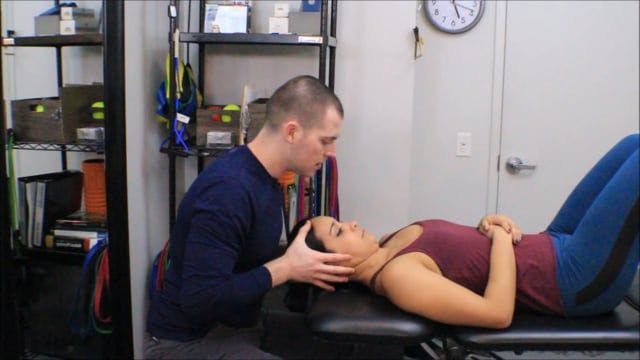Research Review: Incidence of Common Postural Abnormalities in the Cervical, Shoulder, and Thoracic Regions and Their Association with Pain in Two Age Groups of Healthy Subjects
By Susan Ackerman DPT, PT, PMA-CPT
Edited by Brent Brookbush DPT, PT, COMT, MS, PES, CES, CSCS, ACSM H/FS
Original Citation:
Griegel-Morris, P., Larson, K., Mueller-Klaus, K., & Oatis, C. A. (1992). Incidence of common postural abnormalities in the cervical, shoulder, and thoracic regions and their association with pain in two age groups of healthy subjects. Physical therapy, 72(6), 425-431. FULL ARTICLE
Introduction:
Additional research has demonstrated a relationship between upper body postural dysfunction and upper body pain (1-5). Common postural abnormalities of the upper body include forward head posture, rounded shoulders, excessive thoracic kyphosis, and shoulder height asymmetry (6). This 1992 study, out of the Philadelphia Institute of Physical Therapy, demonstrated that participants from two age groups with excessive thoracic kyphosis, forward head, and rounded shoulders had increased incidence of headaches, interscapular pain and cervical pain. This implies the postural assessment may be beneficial for developing injury prevention programs, as well as intervention plans for the treatment of upper body dysfunction and pain.

Study Summary
| Study Design | Observational Study |
| Level of Evidence | III Evidence from non-experimental descriptive studies, such as comparative studies, correlation studies, and case-control studies |
| Participant Characteristics | Demographics
Inclusion Criteria:
Exclusion Criteria:
|
| Methodology |
|
|
|
| Outcome Measures |
|
| Results |
|
| Conclusions | Incidence of postural abnormalities were high in all groups. A linear relationship between the severity of posture and the intensity of pain was not demonstrated. The incidence of pain and subject reported severity of pain was higher in those with the most severe postural abnormalities, suggesting that a threshold level of postural abnormality may be necessary to increase incidence and intensity of pain. |

How this study contributes to the body of research:
This study investigated the relationship between thoraco-cervical-shoulder posture, age, and the incidence and severity of pain. Unique to this study, general signs of postural dysfunction were investigated in two age groups, stratifying posture into 3 levels of dysfunction, demonstrating that the incidence and severity of pain is higher in the group with the largest amount of dysfunction. This study suggests that the relationship between posture and pain is likely dependent on a threshold level of severity and not purely linear.
How the Findings Apply to Practice:
The findings of this study demonstrate a relationship between significant cervico-thoracic-shoulder postural dysfunction and the severity and incidence of pain. This may imply that human movement professionals should assess upper body posture with the intent of reducing the incidence of future pain, as well as identify signs associated with current pain and impairment. Further, human movement professionals should develop a repertoire of techniques that demonstrate effectiveness for improving posture.
Strengths
- This study was the first to investigate the relationship between posture and pain, stratified by severity.
- Participants were divided into two age groups to account for the effect age, and or time exhibiting the dysfunction, may have on the incidence and severity of pain.
- Multiple variables were investigated, allowing for direct comparison. Specifically, signs and levels of severity could be compared to determine the most reliable indicators of pain and dysfunction.
Weaknesses/limitations
- Although stratification likely increased reliability, the assessment used in the study should be investigated for reliability.
- The number of incidence and intensity of pain were gathered using a questionnaire. Relying on participant memory of the painful experience may reduce accuracy.
- The majority of the individuals in the study displayed postural dysfunction; finding matched-controls without dysfunction may have resulted in a more accurate representation of the relationship between posture and pain.
How the study relates to Brookbush Institute Content?
The Brookbush Institute (BI) is continuing to develop and refine its content related to Upper Body Dysfunction (UBD) . This study provided additional evidence of a correlation between thoraco-cervical-shoulder abnormality and pain which reinforces the hypothesis that addressing posture may be beneficial for the treatment and prevention of pain. The BI will continue to pursue optimal practice by refining its content, using the aggregated results of all available research related to human movement science.
Brookbush Institute Videos:
Cervical Extensor Release
Combined Deep Cervical Flexor and External Rotator Activation
Serratus anterior activation
Bibliography:
- Brink, Y., Louw, Q., Grimmer, K., & Jordaan, E. (2015). The relationship between sitting posture and seated-related upper quadrant musculoskeletal pain in computing South African adolescents: A prospective study. Manual therapy, 20(6), 820-826.
- Fernández‐de‐las‐Peñas, C., Alonso‐Blanco, C., Cuadrado, M. L., Gerwin, R. D., & Pareja, J. A. (2006). Trigger points in the suboccipital muscles and forward head posture in tension‐type headache. Headache: The Journal of Head and Face Pain, 46(3), 454-460.
- Harrison, D. D., Harrison, D. E., Janik, T. J., Cailliet, R., Ferrantelli, J. R., Haas, J. W., & Holland, B. (2004). Modeling of the sagittal cervical spine as a method to discriminate hypolordosis: results of elliptical and circular modeling in 72 asymptomatic subjects, 52 acute neck pain subjects, and 70 chronic neck pain subjects. Spine, 29(22), 2485-2492.
- Haughie, L. J., Fiebert, I. M., & Roach, K. E. (1995). Relationship of forward head posture and cervical backward bending to neck pain. Journal of Manual & Manipulative Therapy, 3(3), 91-97.
- Fernández-de-Las-Peñas, C., Cuadrado, M. L., & Pareja, J. A. (2006). Myofascial trigger points, neck mobility and forward head posture in unilateral migraine. Cephalalgia, 26(9), 1061-1070.
- Kendall FP, McCreary EK. Muscles: Testing and Function. 3rd. Baltimore, Md: Williams & Wilkins; 1983:112-113, 116, 270-315.
© 2018 Brent Brookbush
Questions, comments, and criticisms are welcomed and encouraged -


